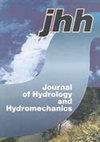Effects of carbonated water injection on the pore system of a carbonate rock (coquina)
IF 2.4
4区 环境科学与生态学
Q3 WATER RESOURCES
引用次数: 2
Abstract
Abstract CO2 injection is a well-known Enhanced Oil Recovery (EOR) technique that has been used for years to improve oil extraction from carbonate rock and other oil reservoirs. Optimal functioning of CO2 injection requires a thorough understanding of how this method affects the petrophysical properties of the rocks. We evaluated pore-scale changes in these properties, notably porosity and absolute permeability, following injection of CO2-saturated water in two coquina outcrop samples from the Morro do Chaves Formation in Brazil. The coquinas are close analogues of Pre-salt oil reservoirs off the coast of southern Brazil. The effects of carbonated water injection were evaluated using a series of experimental and numerical steps before and after coreflooding: cleaning, basic petrophysics, microtomography (microCT) imaging, nuclear magnetic resonance (NMR) analyses, and pore network modeling (PNM). Our study was motivated by an earlier experiment which did not show the development of a wormhole in the center of the sample, with a concomitant increase in permeability of the coquina as often noted in the literature. We instead observed a substantial decrease in the absolute permeability (between 71 and 77%), but with little effect on the porosity and no wormhole formation. While all tests were carried out on both samples, here we present a comprehensive analysis for one of the samples to illustrate changes at the pore network level. Different techniques were used for the pore-scale analyses, including pore network modeling using PoreStudio, and software developed by the authors to enable a statistical analysis of the pore network. Results provided much insight in how injected carbonated water affects the pore network of carbonate rocks.碳酸水注入对碳酸盐岩(coquina)孔隙系统的影响
摘要CO2注入是一种众所周知的提高采收率(EOR)技术,多年来一直用于改善碳酸盐岩和其他油藏的采油效果。CO2注入的最佳功能需要彻底了解这种方法如何影响岩石的岩石物理性质。在巴西Morro do Chaves组的两个coquina露头样品中注入二氧化碳饱和水后,我们评估了这些性质的孔隙尺度变化,特别是孔隙度和绝对渗透率。coquinas与巴西南部海岸的盐前油藏非常相似。在岩心驱油前后,使用一系列实验和数值步骤评估了碳酸水注入的效果:清洁、基础岩石物理、显微CT成像、核磁共振(NMR)分析和孔隙网络建模(PNM)。我们的研究动机是早期的一项实验,该实验没有显示样品中心出现虫洞,同时文献中经常提到的coquina的渗透率增加。相反,我们观察到绝对渗透率显著降低(在71%和77%之间),但对孔隙度几乎没有影响,也没有形成虫洞。虽然所有测试都是在两个样本上进行的,但在这里,我们对其中一个样本进行了全面分析,以说明孔隙网络水平的变化。孔隙尺度分析使用了不同的技术,包括使用PoreStudio的孔隙网络建模,以及作者开发的用于对孔隙网络进行统计分析的软件。研究结果为注入的碳酸水如何影响碳酸盐岩的孔隙网络提供了很多见解。
本文章由计算机程序翻译,如有差异,请以英文原文为准。
求助全文
约1分钟内获得全文
求助全文
来源期刊
CiteScore
4.20
自引率
5.30%
发文量
30
审稿时长
>12 weeks
期刊介绍:
JOURNAL OF HYDROLOGY AND HYDROMECHANICS is an international open access journal for the basic disciplines of water sciences. The scope of hydrology is limited to biohydrology, catchment hydrology and vadose zone hydrology, primarily of temperate zone. The hydromechanics covers theoretical, experimental and computational hydraulics and fluid mechanics in various fields, two- and multiphase flows, including non-Newtonian flow, and new frontiers in hydraulics. The journal is published quarterly in English. The types of contribution include: research and review articles, short communications and technical notes. The articles have been thoroughly peer reviewed by international specialists and promoted to researchers working in the same field.

 求助内容:
求助内容: 应助结果提醒方式:
应助结果提醒方式:


